上海外国语大学语言学及应用语言学07年真题
外文学院20062007学年度第(一)学期期末考试
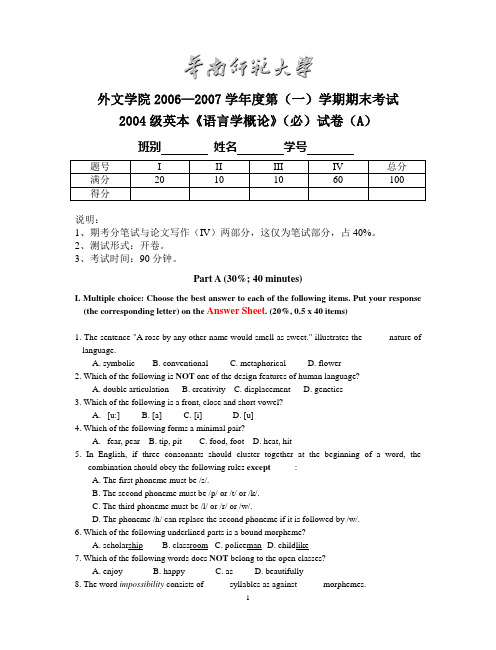
外文学院2006—2007学年度第(一)学期期末考试2004级英本《语言学概论》(必)试卷(A)班别姓名学号说明:1、期考分笔试与论文写作(IV)两部分,这仅为笔试部分,占40%。
2、测试形式:开卷。
3、考试时间:90分钟。
Part A (30%; 40 minutes)I. Multiple choice: Choose the best answer to each of the following items. Put your response (the corresponding letter) on the Answer Sheet. (20%, 0.5 x 40 items)1. The sentence "A rose by any other name would smell as sweet." illustrates the _____ nature of language.A. symbolicB. conventionalC. metaphoricalD. flower2. Which of the following is NOT one of the design features of human language?A. double articulationB. creativityC. displacementD. genetics3. Which of the following is a front, close and short vowel?A.[u:]B. [a]C. [i]D. [u]4. Which of the following forms a minimal pair?A.fear, pearB. tip, pitC. food, footD. heat, hit5. In English, if three consonants should cluster together at the beginning of a word, thecombination should obey the following rules except _____:A. The first phoneme must be /s/.B. The second phoneme must be /p/ or /t/ or /k/.C. The third phoneme must be /l/ or /r/ or /w/.D. The phoneme /h/ can replace the second phoneme if it is followed by /w/.6. Which of the following underlined parts is a bound morpheme?A. scholarshipB. classroomC. policemanD. childlike7. Which of the following words does NOT belong to the open classes?A. enjoyB. happyC. asD. beautifully8. The word impossibility consists of _____ syllables as against _____ morphemes.A. six/threeB. five/twoC. six/fourD. five/five9. For the word "to" in "It is necessary to know yourself.", we can say _____.A. it has a lexical meaningB. it is an inflectional morphemeC. it is a derivational morphemeD. it has a grammatical meaning as an infinitive marker10. In TG, 'S-structure' represents _____ structure.A. surfaceB. sentenceC. specifierD. syntactic11. The words “elevator” and “lift” are ______ synonyms.A. nearB. dialectalC. collocationally-restrictedD. stylistic12. The words “literate” and “illiterate” are ______ opposites.A. gradableB. ungradableC. relationalD. complementary13. Whi ch of the following is the correct componential analysis of the word “cake”?A.[+FOOD-SOLID+COUNTABLE]B.[+FOOD+SOLID+COUNTABLE]C.[+DRINKS-LIQUID-COUNTABLE]D.[+DRINKS+LIQUID-COUNTABLE]14. “It‟s foggy today.” is a _____-place predication.A. noB. oneC. twoD. three15. A predication consists of _____.A. argumentsB. predicatesC. argument(s) and predicatesD. argument(s) and predicate16. _____ is often regarded as a high-status marker.A. sociolectB. idiolectC. registerD. accent17. Which of the following best describes the relation between “He is alone” and “He has no oneto talk to”?A. The former is synonymous with the latter.B. The former is inconsistent with the latter.C. The former entails the latter.D. The former presupposes the latter.18. Which of the following best describes the relation between “He paid a visit to Sydney.” and“He paid a visit to Australia.”?A. The former is synonymous with the latter.B. The former is inconsistent with the latter.C. The former entails the latter.D. The former presupposes the latter.19. Which of the following best describes the relation between “Her sister is coming.” and “Shehas a sister.”?A.The former is synonymous with the latter.B.The former is inconsistent with the latter.C.The former entails the latter.D.The former presupposes the latter.20. …Statesman‟ and …politician‟ are ___.A. dialectal synonymsB. collocational synonymsC. stylistic synonymsD. synonyms that differ in their emotive meaning21. The relation between …furniture‟ and …desk‟ is ___.A. homophonyB. homographyC. polysemyD. hyponymy22. …Mother‟ and …daughter‟ are ___.A. gradable antonymsB. relational oppositesC. ungradable oppositesD. complementary synonyms23. According to Searle, acts bringing about immediate changes by saying something are _____.A. representativesB. directivesC. expressivesD. declarations24. Which of the following is a commissive?A.I‟m really sorry to hear that.B.I will see you without fail.C.You‟d better have dinner at once.D.I now declare the meeting open.25. “Why not offer him a lift?” is an instance of ____.A.representativesB.expressivesC. directivesD. commissives26. Which of the following is a declaration?A. Close the window, please.B. Would you like to go to the movie with me?C. I‟ve never seen him before.D. I appoint you monitor of the class.27. The word “mike” is a(n) ____.A.acronymB. blendC. clipped wordD. coined word28. The pronoun "our" was once spelt as "ure/urum" in Old English and "oure" in Middle English.It is the result of going through _____.A. a change in "agreement" ruleB. a change in negation ruleC. a process of simplificationD. the loss of inflections29. The word “motel” is a(n) ____.A. acronymB. blendC. clipped wordD. coined word30. “Down you come, chaps!” belongs to ____ language.A. intimateB. frozenC. consultativeD. casual31. The linguist____ is the one who distinguishes three social variables (Field, Mode, Tenor) thatdetermine the register.A. ChomskyB. HallidayC. BloomfieldD. Skinner32. The Eiffel Tower belongs to ____ culture.A. spiritualB. materialC. folkD. none of the above33. Langua ge acquisition refers to the child‟s acquisition of his ____.A. second languageB. foreign languageC. target languageD. mother tongue34. The first consonants the child can make are made with the lips and they are ____.A. [p, b, d]B. [t, d, k]C. [t, d, m]D. [p, b, m]35. If the child calls all wo men “Aunt”, then we may say the child has ____ the meaning of theword “Aunt”.A. overgeneralizedB. overextendedC. overusedD. overstressed36. The chief exponent of the behaviorist view of language acquisition is ____.A. BloomfieldB. ChomskyC. FirthD. Skinner37. It has been claimed that the garden path effect results from two principles of parsing: _____.A. minimal attachment and late closureB. word and sentence ambiguityC. selectional restrictions and hierarchical structureD. lateralization and aphasia38. Instances of mother tongue interference can be found at the level of ____.A. pronunciationB. syntaxC. lexisD. all of the above39. Which of the following sentences is an example of overgeneralization?A. Jane told me to give up smoking.B. Jane asked me to give up smoking.C. Jane hoped me to give up smoking.D. Jane advised me to give up smoking.40. Which of the following is an example of overgeneralization?A. sheepB. storiesC. booksD. footsII. True or False: Decide whether the following statements are true or false (A for True, andB for False). Put your response on the Answer Sheet. (10%, 0.5 x 20 items)41. The difference between langue and parole was made in the early 20th century.42. Cultural transmission means that the details of the language system are genetically transmittedfrom generation to generation.43. The transcription normally used in dictionaries and textbooks is narrow transcription.44. Spectrographs are used in acoustic phonetics.45. In English, pronouns belong to open class words.46. Some derivational morphemes do not change the grammatical class of its root.47. Category refers to a group of linguistic items which fulfill the same or similar functions in aparticular language such as a sentence, a noun phrase or a verb.48. Phrases that are formed of more than one word usually contain the elements of head, specifierand complement.49. When a word becomes a new word by means of functional shift, it means that there is noaddition of any affix.50. The word "holiday" we use today has gone through a process of narrowing of meaning.51. One of the most important features of diglossia is the specialization of function of the twovarieties.52. As a result of increasing immigration in the world, bilingualism is spreading.53. Language helps perpetuate the culture, and the changes in language uses reflect the culturalchanges in return.54. Each culture presents to its members the ideas and concepts that culture transmits fromgeneration to generation.55. Not all the children achieve the same level of language development.56. Children tend to learn to acquire the sound of [t] before [p].57. Second language acquisition established itself as a discipline around the 1970s.58. According to the Input Hypothesis, there is a formula: i + 1, where i represents learner'scurrent state of knowledge, and the next stage is "i + 1".59. Language processing involves either bottom-up or top-down processing.60. It is found that left-handers are generally less lateralized for language.班别姓名学号Introduction to Linguistics Final Exam, Jan. 30th, 2007.Part B (10%; 50 minutes)III. Explain each of the following linguistic phenomena, indicating (a) the relevant theory or approach in brackets at the end of the text, (b) your understanding of it, and (c) its implication or your conclusion. Write your response (in English) in the blanks given.(10%, 5x2 items)61. A: Did you ask Uncle and Auntie to come, John?B: I asked Uncle to come, Mum. (Cooperative Principle)62. Alexander Pope puts his poem entitled An Empty House in a form as follows:You beat your pate, and fancy wit willcome:knock as you please, there is nobody athome.(language change)。
(完整word版)语言学及应用语言学经典习题

二、语言学及应用语言学经典习题(一)单项选择题1、关于语言符号的任意性,下列说法不正确的一项是( )A、复合符号原则上不是任意的,是有理据的B、正是由于语言符号的任意性,语言是可变的C、最基本的单纯初始符号都是任意的D、任意性是指一个符号先由某一个群体约定,继而向周围扩散推广2、关于书面语,下列表述不正确的一项是( )A、书面语是在口语的基础上产生的,经过加工和提炼,比较规范,所以,语言研究应该首先研究书面语B、书面具有相对的独立性C、任何语言总是先有口语,后有书面语D、书面语和口语的差异主要是风格上差异3、产生与18世纪末叶19世纪初叶的语言学被称为( )A、结构主义语言学B、历史比较语言学C、社会语言学D、功能语言学4、组合关系现在一般称为( )A、联想关系B、类聚关系C、句法功能D、语义组合5、语音的四个物理要素中,区别不同的意义起着最为重要的作用的是( )A、音高B、音强C、音长D、音色(二)、多项选择题在每小题列出的五个备选项中有二个至五个是符合题目要求的,请将其代码填写在题后的括号内。
错选、多选、少选或未选均无分。
1、一个元音的发音特征取决于( )A、起主要作用的部位B、声带是否振动C、唇形的圆展D、舌位的前后E、舌位的高低2、基本词汇的特点是( )A、数量最多B、使用范围广C、理据性强D、产生历史长E、构词能力强3、根据字符跟语言单位的语义还是语音相联系的标准可以将文字分为( )A、音节文字B、音位文字C、表意文字D、意音文字E、表音文字三、名词解释1、发音方法2、语法单位的构成关系四、简答题简述索绪尔对语言学的主要贡献。
五、分析题试从词语的构造方式的角度对下列合成词进行分类,分别填入相应的各项中:修辞阿姨瓜子燕子女儿马儿作者司仪刚刚第三作为忘记窗户木头开头后现代后年词根和词根组合的合成词词根和词缀组合的合成词前加式派生词后加式派生词六、论述题(本大题共2小题,第1小题10分,第2小题9分,共19分)举例说明几种主要的语法手段。
北京外国语大学 02-07 语言学及应用语言学真题

2002年语言学与应用语言学(100 points)All the questions are to be answered in English on the answer sheets provided.1. Displacement,arbitrariness,productivity,cultural transmission,discreteness and duality are sometimes listed as the 6 core features of human language.Choose 3 out of the 6 and explain with examples what they mean. (12 points)2. Briefly explain what phonetics and phonology are concerned with and what kind of relationsips hold between the two.(10 points)3.In deriving new words via a prefix such as mis-, there seems to be some constraint on what is permitted. The words in the first colum below are acceptable formations,but in the other columns are not.Work out what the rule(s) might be for making new adjectives with the prefix mis-. (18 points)Column I : misadventure misjudgement misplaced mistrustfulColumn II: *mishappy *mismeal *misglad *misroleColumn III: *mismilk *missad *misword *miscrazy4. Using what you know about Grice's cooperative principle and its four maxims,analyze the following short exchange.(20 points)同事甲:小张昨晚去哪儿了?同事乙:今天在早上我看见一辆白色富康停在小林家门口。
上海外国语大学语言学考研07-13真题

上海外国语⼤学语⾔学考研07-13真题07年416语⾔学概论"试题(完整版)⼀.术语解释(20分)1.语⾔2.组合关系3.⾳位4.合成词⼲5.语义场6.根词语7.随位⾳变8.区别性特征9.异根10.义素⼆.选择(20分)1.按语法⼿段进⾏分类,汉语和英语__. a.都属于分析语b.都属于综合语c.汉语属于分析语,英语属于综合语d.汉语属于综合语,英语属于分析语页脚内容12.__不是超⾳段⾳位. a.重⾳b.停顿c.⾳渡d.同化3.汉语拼⾳中字母b所表⽰的⾳是⼀个__. a.送⽓⾳b.擦⾳c.清辅⾳d.浊辅⾳4."玻璃球"⼀词有__语素. a.⼀个b.两个c.三个5.语⾔中能独⽴运⽤的⾳义结合的最⼩语⾔单位是__. a.⾳素b.语素c.词d.句⼦6."⽼板"⼀词中"⽼"是__. a.词b.词根c.构词词缀d.构形词缀7.按照传统⽂字学,汉字属于__. a.语段⽂字b.表意⽂字c.表⾳⽂字d.⾳节⽂字8.美国描写语⾔学的代表⼈物是__. a.乔姆斯基b.索绪尔c.布龙菲尔德d.韩礼德9."啤酒"/pijiu/⼀词的发⾳中,/p/已经__. a.同化b.腭化c.⿐化d.变调10."葡萄酒杯"⼀词有__语素. a.⼀个b.两个c.三个d.四个11.在⼀个词中,__. a.只有⼀个词根b.⾄少有⼀个词根c.不⼀定有词根d.⼀定没有词根12.英语词desks和tables中复数语素"-s"的发⾳不同但书写上都⽤s表⽰,它遵循的拼写法原则是__.a.语⾳原则b.形态⾳位原则c.历史传统原则d.辨义原则13.下列词语中不是词汇单位的是__. a.风调⾬顺b.吃⼀堑,长⼀智c.对不起d.⿊墨⽔14.语⾳的本质属性是__. a.物理属性b.⽣理属性c.社会属性d.区别性特征15.__是历史⽐较语⾔学的奠基⼈之⼀. a.弗斯b.拉斯克c.叶尔姆斯列夫d.索绪尔16.在句⼦"书买来了"中,"书"在语义上是__. a.定指的b.不定指的c.通指的d.泛指的17."江""河"两词在古汉语中分别指"长江""黄河",在现代汉语中它们都由专名变为通名了,这种变化叫做__. a.语义扩⼤b.语义缩⼩c.语义转移d.派⽣新义页脚内容2。
2010年上海外国语大学语言学及应用语言学考研真题回忆版
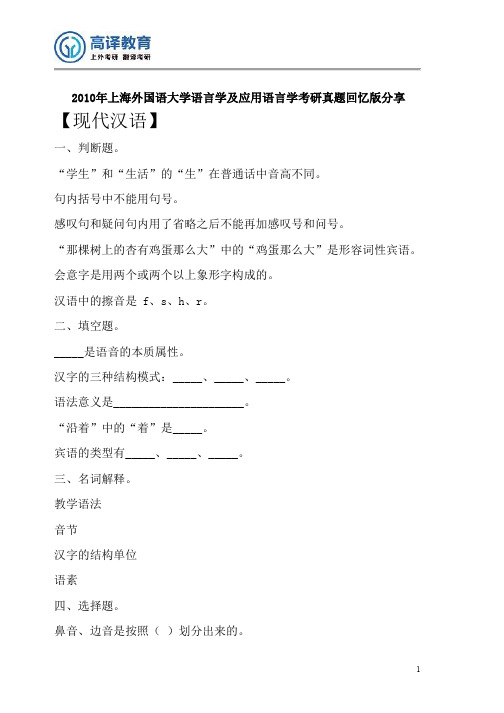
a. 重音 b. 停顿 c. 音渡 d. 同化 13 汉语拼音中字母 b 所表示的音是一个( )。
a. 送气音 b. 擦音 c. 清辅音 d. 浊辅音 ( )学派的突出成就是音位学。 ( )是最早的有序文字体系。 ( )不是超音段音位。 a. 重音 b. 停顿 c. 音渡 d. 同化 17 语言中能够独立运用的音义结合的最小语言单位是( )。 a. 音素 b. 语素 c. 词 d. 句子 18 “啤酒”/pijiu/一词的发音中,/p/已经( )。 a. 同化 b. 腭化 c. 鼻化 d. 变调 19 单义性、体系性和( )是科技术语的特点。 20 汉语语音体系中,( )是音节的必要组成成分。 五、问答题。 1 从六十年代后期到整个七十年代,西方语言学界开展了一场语义和 句法问题的学术讨论,扩充式标准理论、格语法、生成语义学形成三 足鼎立 的局面,请说明三者对语义问题的看法。 2 举例说明“句法同义”和“句法多义”。举例说明变换分析如何利
【语言学概论】
一、名词解释。 义素 音位变体 社会方言
3
协音变化 内部屈折 句子的实义切分方法 词根 修辞 借词 二、填空题。 1、英语属于_____语系_____语族;汉语属于_____语系_____语族;按语 言类型分类,英语属于_____,汉语属于_____;按语法手段分类,英语 属 于_____,德语属于_____,汉语属于_____。 2、结构主义语言学派有_____、_____、_____、_____、_____。结构语 言学各流派是以_____的语言学理论为基础。 4、转换生成语言学由_____提出,他认为语言学的对象是_____,而不是 _____。70 年代转换生成语法的研究重点是_____,80 年代以后,其研 究 重点由______转到______。 5、语流按一定特征分解成的不同语音单位包括_____、_____、_____、 _____、_____。其中,以重读音节为中心连接起来的节奏组是_____,_____ 是一个发音动作构成的最小语音单位。 6、表示附加词汇意义的词缀是_____,表示语法意义的词缀是_____,如 “桌子”一词中“子”是_____,workers 中-er 是_____,-s 是_____, working 中-ing 是_____。 7、对具体语言的体系及其特点进行描写研究的语言学是_____,概括各
语言学历年真题试卷汇编15.doc
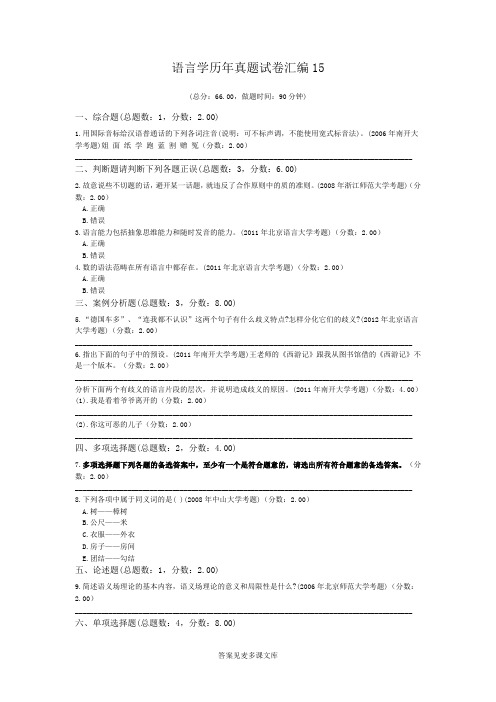
语言学历年真题试卷汇编15(总分:66.00,做题时间:90分钟)一、综合题(总题数:1,分数:2.00)1.用国际音标给汉语普通话的下列各词注音(说明:可不标声调,不能使用宽式标音法)。
(2006年南开大学考题)姐面纸学跑蓝割赠冤(分数:2.00)__________________________________________________________________________________________二、判断题请判断下列各题正误(总题数:3,分数:6.00)2.故意说些不切题的话,避开某一话题,就违反了合作原则中的质的准则。
(2008年浙江师范大学考题)(分数:2.00)A.正确B.错误3.语言能力包括抽象思维能力和随时发音的能力。
(2011年北京语言大学考题)(分数:2.00)A.正确B.错误4.数的语法范畴在所有语言中都存在。
(2011年北京语言大学考题)(分数:2.00)A.正确B.错误三、案例分析题(总题数:3,分数:8.00)5.“德国车多”、“连我都不认识”这两个句子有什么歧义特点?怎样分化它们的歧义?(2012年北京语言大学考题)(分数:2.00)__________________________________________________________________________________________ 6.指出下面的句子中的预设。
(2011年南开大学考题)王老师的《西游记》跟我从图书馆借的《西游记》不是一个版本。
(分数:2.00)__________________________________________________________________________________________ 分析下面两个有歧义的语言片段的层次,并说明造成歧义的原因。
(2011年南开大学考题)(分数:4.00)(1).我是看着爷爷离开的(分数:2.00)__________________________________________________________________________________________ (2).你这可恶的儿子(分数:2.00)__________________________________________________________________________________________四、多项选择题(总题数:2,分数:4.00)7.多项选择题下列各题的备选答案中,至少有一个是符合题意的,请选出所有符合题意的备选答案。
上海外国语大学640外国语言学及应用语言学理论2015考研专业课试题

上海外国语大学2015年硕士研究生入学考试
外国语言学及应用语言学专业
外国语言学及应用语言学理论试题
(考试时间180分钟,满分150分,共2页)
一、汉语部分(共105分)
Ⅰ. 术语解释(5×3,共15分)
本部分为5个语言学术语,请解释其定义及含义,必要时可举例说明。
1.语言任意性
2.韵律特征
3.社会方言
4.言语事件
5.语言潜势
Ⅱ. 问答题(6×15,共90分)
本部分为6道问答题,请就所给的问题做简短回答,有必要时请具体举例说明。
1.索绪尔对现代语言学的主要贡献是什么?
2.请说明什么是宏观语言学及其分类,必要时可以列举其代表。
3.请简要介绍美国社会语言学家海姆斯“交际语言能力”理论的主要内容。
4.什么是转换生成语法?请简要介绍。
5.什么是语言同化?试举例说明语言同化的分类。
6.什么是应用语言学,请简要说明它与语言学的关系。
第 1 页共2 页。
06年真题分析语言学及应用语言学(现代汉语+语言理论)
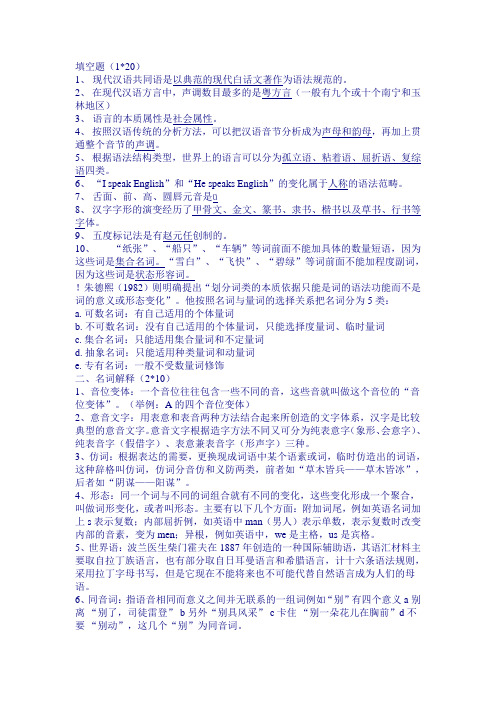
填空题(1*20)1、现代汉语共同语是以典范的现代白话文著作为语法规范的。
2、在现代汉语方言中,声调数目最多的是粤方言(一般有九个或十个南宁和玉林地区)3、语言的本质属性是社会属性。
4、按照汉语传统的分析方法,可以把汉语音节分析成为声母和韵母,再加上贯通整个音节的声调。
5、根据语法结构类型,世界上的语言可以分为孤立语、粘着语、屈折语、复综语四类。
6、“I speak English”和“He speaks English”的变化属于人称的语法范畴。
7、舌面、前、高、圆唇元音是ü8、汉字字形的演变经历了甲骨文、金文、篆书、隶书、楷书以及草书、行书等字体。
9、五度标记法是有赵元任创制的。
10、“纸张”、“船只”、“车辆”等词前面不能加具体的数量短语,因为这些词是集合名词。
“雪白”、“飞快”、“碧绿”等词前面不能加程度副词,因为这些词是状态形容词。
!朱德熙(1982)则明确提出“划分词类的本质依据只能是词的语法功能而不是词的意义或形态变化”。
他按照名词与量词的选择关系把名词分为5类:a. 可数名词:有自己适用的个体量词b. 不可数名词:没有自己适用的个体量词,只能选择度量词、临时量词c. 集合名词:只能适用集合量词和不定量词d. 抽象名词:只能适用种类量词和动量词e. 专有名词:一般不受数量词修饰二、名词解释(2*10)1、音位变体:一个音位往往包含一些不同的音,这些音就叫做这个音位的“音位变体”。
(举例:A的四个音位变体)2、意音文字:用表意和表音两种方法结合起来所创造的文字体系,汉字是比较典型的意音文字。
意音文字根据造字方法不同又可分为纯表意字(象形、会意字)、纯表音字(假借字)、表意兼表音字(形声字)三种。
3、仿词:根据表达的需要,更换现成词语中某个语素或词,临时仿造出的词语,这种辞格叫仿词,仿词分音仿和义防两类,前者如“草木皆兵——草木皆冰”,后者如“阴谋——阳谋”。
4、形态:同一个词与不同的词组合就有不同的变化,这些变化形成一个聚合,叫做词形变化,或者叫形态。
上海外国语大学考研语言学概论真题回忆+答案2016

上海外国语大学考研2016年语言学概论真题回忆版一、名词解释(20*2’)1、语言符号的线条性2、聚合关系3、语法意义4、语言类型分类5、文字类型分类6、语义7、结构语言学8、转换生成语法9、语流音变10、义素分析法11、语体12、异根13、派生词14、直接成分分析法15、语言和言语16、语义场17、历史比较法18、音位19、熟语20、语言的规范化二、多项选择(10*2’)1.汉语一个音节可以有个音素。
a.1b.2c.3d.4e.52.就语言的共同来源而言,__同属一个语族。
a.汉语和日语b.法语和意大利语c.西班牙语和希腊语d.英语和德语3.属于言语修养的标准。
a.逻辑性b.含蓄性c.健康性d.浅显性4.Books和Rooms;write和right涉及到下列拼写法原则。
a.语音原则b.形态音位原则c.历史传统原则d.辨义原则5.历史比较语言学的代表人物是。
a.葆朴b拉斯克c哈利迪d沃斯托克夫6.汉语体范畴包括。
a.进行体b.完成体c.短暂体d.未然体7.下列语言属于分析语的是。
a汉语b意大利语c英语d法语8.下列属于符号的是。
a信号灯b旗语c上课铃d盲文9.科技术语的特点是。
a单义性b描述性c体系性d理据性10.下列语言有声调的有。
a古梵语b景颇语c泰语d韩语三、填空(20分)1.思维规律是全人类的,而语言规律具有特点。
2.仿词的涌现,是规律起作用的结果。
试举一例。
3.是语言分化的主要原因。
4.汉语语音体系中和是音节的必要组成成分。
5.根据语言功能特征的分类,普通话属于标准语,解放前上海使用的洋泾浜语是。
6.符号学术语semantics、pragmatics、syntactic分别相当于语言学中的__、__、__。
其中,__专门研究语言单位同交际主体之间的关系。
7.我国第一部语义词典是;杨雄的《方言》提出了的概念;是中国古代第一部系统分析字形和考证字源的字书。
8.stood中的“t”是发生了音变。
2021上海外国语大学语言学及应用语言学考研真题经验参考书

上海外国语大学——语言学及应用语言学考研我是上届参加考研的学姐,成功被上海外国语大学语言学及应用语言学专业录取。
如今考成归来,为回馈论坛,也为给正在备考的你们提供一些复习的经验和方法,特意写下这篇帖子,希望能对你们有所帮助。
先说说关于择校的问题,对于考研来说,目标定的好才能提升你的成功率,择校不能盲目,下面5个要素都要认真考虑:要素一考研目标可以说专业和性格都是确定你的方向的问题,学校是决定你能不能考上的问题,同样一个专业,全国那么多学校开设,他的难度可大可小,所以定学校关键看成功率,建议大家以自己的实力是衡量专业,不要好高骛远。
大家在专业选好后,可以针对性的选择学校,而且要考虑是否符合考研目标。
要素二城市地域考研专业确定之后,同学们要做的事情就是结合“城市”选学校。
在选学校的时候为什么要考虑“城市”的因素呢?有两个原因:第一,根据教育部的统计,我们发现70%的研究生就业是选择本地就业,因此在报考的时候就要认真思考自己毕业之后是否想留在高校所在地工作。
第二,每个城市的高校培养的学生或多或少都会打上当地的烙印,正所谓一方水土养育一方人,每个人都有属于自己的性格以及特点,因此当地研招办对于当地的生源有着天然的亲近感。
当然每个人也都会有自己钟情的区域,很多大家会选择到一线城市读研,他们认为,大城市上学可以开拓眼界,学到更多知识,还可以感受大城市各种前卫的东西,同时211院校和985院校确实较多集中于大城市。
要素三院校竞争各招生单位的招生自主权很大,因此必须详细了解:第一是看招生单位的录取分数线,是高于还是低于全国统一最低分数线。
第二是看所要报考的专业院系的录取的平均分和最低分数。
第三是看报考人数和招生人数的录取比例,了解竞争的激烈程度。
要素四个人水平很多大家都有一种“名校情结”,对知名高等院校抱有的一种带有强烈偏爱的主观意愿和报考倾向。
无论从学校的硬件条件还是软件环境来看都具有相当实力的高校,它们对大家无疑具有非常大的吸引力,但由于报考人数众多,竞争也非常激烈。
上海外国语大学语言学及应用语言学专业2016年硕士复试一志愿考生拟录取结果及成绩

上海外国语大学语言学及应用语言学专业2016年硕士复试一志愿考
生拟录取结果及成绩
本表按考生初复试总成绩降序排列
外语/二外听说
18690.2571.16395.5102716210001965录取非定向就业孙倩84.5
28286.6544.01377.5102716210002786录取非定向就业刘爽77
36883528.74376.7102716210003006录取非定向就业杨岚86.5
47982.6527.17368.7102716210001330录取非定向就业李静75
58282525.43361.2102716210002925录取非定向就业冀娜79
67084.2525.26368.3102716210002028录取非定向就业孙思85
77984.2518.58361102716210003423录取非定向就业黄佐65
87683.6517.79351.5102716210002410录取非定向就业赵钰晗86
98181.8517.19367.7102716210003557录取非定向就业王思琪55
107682.8517.08359.2102716210002546录取非定向就业夏晓晓75
117485.8513.38349.3102716210002547录取非定向就业苑振彪78 126682.6503.82350.9102716210002083录取非定向就业方萍82 137236.4449.58361.9102716210002789不录取郭*83
146130.6
文章来源:文彦考研旗下上海外国语大学考研网。
上海外国语大学英语语言文学语言学全真模拟题

上海外国语大学英语语言文学语言学全真模拟题I.Define each of the following concepts and theories: (36 points)1.IPA2.Duality3.Vowel glideplementary distribution5.Illustrate root and stem6.Illustrate the NUMBER issue with both English and Chinese lexical items.putational linguisticsurence Horn’s Q-and R-principles.9.List at least four components of a communicative syllabus.II.Fill in the blanks with the words that are most appropriate in the given context.(16 points)1.In Austin’s How to Do Things with word, he first distingu ishes ________ and______. Later on Austin made a fresh start to distinguish ______, _______ and ________.2._______ is a branch of linguistics which is the study of psychological aspectsof language. As an ______ academic field, it investigates the following major subjects:________, _______ and _______.3.Words can be classified as _______ and ______words; _____ words and______words, ______-class words and _____-class words.III.Answer the following questions. (24 points)1.Describe with tree diagrams the transformations involved in forming thequestion “Does John like the book?”2.State and interpret the sense relations with examples.IV.Answer the following questions and try to elaborate the points indicated in questions with the knowledge you have acquired. (24 points)Explain the differences between the Chinese and English cultures by illustrating one aspect of life, which is rich in Chinese but limited in English, and vice versa.Ⅴ. Discuss the following question with examples (50 points)1. What are the methods for the addition of new words in the English language?2. When a teacher says “it’s hot in here” during a class, what does she probablymean? Refer to the theory of pragmatics when you analyze the situation.ReferencesⅠDefine each of the following concepts and theories: (36 points)1. IPA refers to the acronym of the International Phonetic Association (1897) whose first title was Phonetic Teachers Association established by a small group of language teachers in France in order to popularize their teaching practice or methods.(2分) It also stands for the International Phonetic Alphabet (the IPA chart) first proposed by the Danish grammarian and phonetician Otto Jesperson in1886, whose first version was published in 1888.(2分)(本题主要考查语音学中国际音标的起源)2.Duality: the structural organization of language into two abstract levels: meaningful units (e.g. words) and meaningless segments (e.g. sounds, letters).(3分) It is one of human language’s design features. (1分)(本题考查人类语言设计特征的二重性)3.Vowel glide: vowel that involve a change of quality,(2分) including diphthones, when a single movement of the tongue is made, and triphthones, where a double movement is perceived. (2分)(本题主要考查滑元音,包括双元音滑元音和三元音滑元音)4. Complementary distribution: when two sounds never occur to the same environment, they are in complementary distribution.(3分) For example, the aspirated English plosives never occur after [s], and unaspirated ones never occur initially. (1分)(本题考查音位学的互补分布特征的本质)5.Root refers to the base form of a word that cannot be further analyzed without loss of identity. For example, it is that part of the word which is left when all the affixes are removed.(1分) In the word internationalism, after the removal of inter-, -al, -ism, the part left is the root nation. Apparently, all words contain a root morpheme. And roots can be further classified into free root morpheme and bound root morpheme. (1分)Stem is any morpheme or combinations of morphemes to which an inflectional affix can be added.(1分) For instance, friend- in friends, and friendship in friendships are both stems. The former shows that a stem may be the same as a root, whereas the latter shows that a stem may contains a root and one, or more than one,derivational affix. In another word, friendship is a stem, but not a root.(1分) (本题考查词根和词干的定义及其异同)6. In English the NUMBER lexical items are regular and popular suffix which can be added to the verbs and nouns that distinguish the singular number (one or one group or part), plural form (more than one). In English nouns, we have book/books, pen/pens, hero/heroes, each of the former indicating the singular form (with no suffix or zero suffix), while the latter refers to the plural form, with the suffix (e)s. There are irregular forms in English pronouns, such a I/we, me/us, my/us,so on, indicating the distinction between the singular form and plural form. English verb has present tense the third person singular, for instance,Mary works, Mary teaches French. English verbs also has the irregular, for instance, have/has, am/is/are, which are not large in amount but fixed in usage.(2分)In Contrast, Chinese has few lexical items to indicate the grammatical category NUMBER, such as students (学生们),children(孩子们),workers (工人们), indicating human beings’ plural forms, or prof essions. This seldom occurs to the nouns referring to non-human things, such as 桌子们,椅子们with the exception that they are used in scientific fiction or children’s fairies. Chinese has singular and plural distinction in pronouns for example, 我/我们, 他/他们,你/你们.In Chinese, we have a few expressions DUAL in terms of units, such as 一双,一副,一对,一套. In contrast, English has only “a pair of”, “a couple” .There is no distinction in the number of Chinese verbs.(2分)(本题考查句法学中的汉语和英语在语法范畴“数”的异同及其各自的特点)7. Horn’s Q-principle: The Q-principle (Hearer-based):MAKE YOUR CONTRIBUTION (cf. Quantity1)SAY AS MUCH AS YOU CAN ( given R) (2分)R-principle: The R-principle (Speaker-based):MAKE YOUR CONTRIBUTION NECESSARY (cf. Relation, Quantity2 Manner)SAY NO MORE THAN YOU MUST (given Q) (2分)(本题主要考查语用学理论的新发展——后格赖斯时期理论)8. Computational linguistics is a branch of applied linguistics, dealing with computer processing of human language. (2分) It includes programmed instruction, speech synthesis and recognition, automatic translation, and computer mediated communication. (2分)(本题考查应用语言学中计算语言学的定义)municative syllabus aims at the learners’ communicative competence. (1分) This syllabus was summarized by Yalden (1983) with ten components as follows: (1分)(1). as detailed a consideration as possible of the purposes for which the learnerswish to acquire the target language.(2). some idea of the setting in which they will want to use the target language(physical aspects need to be considered, as well as social setting); (1分)(3). the socially defined role the learners will assume in the target language, aswell as the roles of their interlocuters.(4).the communicative events in which the learners will participate: everydaysituations, vocational or professional situations, academic situations, and soon. (1分)(5). the language functions involved in these events, or what the learner willneed to be able to do with or through the language;(6). the notions involved, or that the learner will need to be able to talk about;(7). the skills involved in the “knitting together” of discourse: discourse andrhetorical skills.(8). the variety or varieties of the target language that will be needed, and thelevels in the spoken and written language which the learners will need toreach;(9). the grammatical content that will be needed;(10). the lexical content that will be needed.(本题考查应用语言学中语言教学中交际教学大纲的特征,选择4种就得满分4分)Ⅱ. Fill in the blanks with the words that are most appropriate in the given context.(16 points)1.performatives, constatives, locutionary act, illocutionary act, perlocutionary act. (5分)(本题考查语用学中言语行为理论的起源及奥斯汀对自己的理论的提出及其阐述)2.psycholinguistics, interdisciplinary, acquisition, production, production (5分)(本题考查应用语言学中心理语言学的定义及其特征)3.variable, invariable, grammatical (functional/structural),lexical(content/notional), open, closed (6分)(本题考查从不同角度出发对词类进行的不同分类,属于词汇学或形态学范畴)ⅢAnswer the following questions and try to elaborate the points indicated in questions with the knowledge you have acquired. (24 points)1.Describe with tree diagrams the transformations involved in forming thequestion “Does John like the book?”1. The first diagram is shows the D-structure and the second the S-structure.CPC SNP VPV NPDet. NJohn does like the book?”(12分)(本题考查树型图在转换生成语法理论的地位及其对句子结构和句子成分之间的关系)2 State and interpret the sense relations with examples.There are three sense relations: sameness relation, oppositeness relation and inclusiveness relation. (4分)Synonymy is the technical name for the sameness relation. English is rich in synonyms. e.g. buy/purchase; world/universe; wide/broad, autumn/fall. (1分) In Chinese, “父亲”和“爸爸”,“打死”,“搞死”,“整死”,“弄死”,“掐死”,“玩死”and so on, total synonymy is rare. (1分)Antonymy is the name for oppositeness relation whose three main sub-types are gradable antonymy (old/young; long/short);complementary antonymy (alive/dead, pass/fail, odd/even) and converse antonymy (husband/wife, parent/child, over/under ) (4分)The notion of inclusiveness can be seen in the following example. The meaning of desk is included in that of furniture. Hyponymy is a matter of class membership.The upper term in this sense relation, the class name, is called SUPERORDINANT, and the lower terms, the members, hyponyms. Another classical example is, flower/ poeny, tulip, violet, carnation. (2分)(本题考查词汇学或语义学知识,从同义关系,反义关系和上下义关系三个角度解释了主要意义关系,这里主要解释了词或词组之间的关系;而句子之间的关系也是一种意义关系,只是更加复杂,例如,同义反复关系,e.g. War is war.; 前提关系,矛盾关系,衍推关系等等,更复杂)ⅣAnswer the following questions and try to elaborate the points indicated in questions with the knowledge you have acquired. (24 points)Explain the differences between the Chinese and English cultures by illustrating one aspect of life, which is rich in Chinese but limited in English, and vice versa.Different culture feature—be they environmental, material, or social—produce different linguistic features. (4分) 1) One aspect of life which is rich in Chinese but limited in English is the kinship terms. The kinship field is generally built around the lexical differentiation of three fundamental human family relations:filiations, consanguinity and spouseship. In English different words are used primarily to distinguish the set of kin relations, e.g. “brother” and “sister”, “aunt” and “uncle”, etc., but in Chinese distinction is also made lexically between members of kin who are older or younger than the speaker, or his/her parents, who are on the maternal side or on the paternal side, and who are in-laws or not. Thus, for the English “aunt,” we have in Chinese “gu”(father’s sister), “shen”(wife of father’s younger brother), “bomu”(wife of father’s elder brother), “yimu”(mother’s siter) and “jiuma”(wife of mothers’ brother).(8分)2) One aspect of life which is rich in English but limited in Chinese is the horse words. (4分) The fact that English boasts a large number of horse words is a ready explanation in the important part horse plays in the life of the English people. Besides the most common word “horse”, there are “gee” (a term for horse used by children), “horseflesh”(ho rse considered as a group, especially for driving, riding, or racing),“steed” (a spirited horse), “mare”(a young female horse), “foal” (the young offspring of a horse), “colt”(a young male horse), “filly”(a young female horse), “pony” (horse small in size when full grown), “thoroughbred” (a purebred or pedigree horse), and “bay” (a reddish brown horse). (8分)(本题主要考查中英文化差异,文化学习是外语学习的一个重要课题)Ⅴ1What are the methods for the addition of new words in the English language?New words are created through the following processes:a. Invention. It is a word-formation process related to the developingeconomic activities. New lexical items come directly from the consumer items, their producers or their brand names, such as “Coke”, “nylon”, “Kodak” and so on.b. Blending: It is a relatively complex form of compounding, in which twowords are blended by joining the initial part of the first word and the final part of the second word, or by joining the initial parts of the two words; such as smog (smoke + fog), digicom (digital + computer).c. Abbreviation: The process of abbreviation refers to that a new word couldbe created by cutting the final part, or cutting the initial part, or cutting both the initial and final parts accordingly.Such as ad, (advertisement), van (caravan) , flu (influenza).d. Acronym. It is made up from the first letters of the name of anorganization, which has a heavily modified headword, such as WTO, UNESCO.e. Backformation. It refers to an abnormal type of word-formation where a shorter word is derived by deleting an imagined affix from a longer form already in the language. For example, “edit” is a word generated from “editor.”f. Analogical creation. Roughly speaking, this process is one whereby wordsare created in imitation of other words. For example, the appearance of the word “talkathon” is created on the model of “marathon.”g. Borrowing. It refers to the fact that Eng1ish has borrowed words fromother language. For example, the word “cancer” and “tumor” were borrowed from Latin.h. Derivation. New words can be created by the addition of derivational affixes, such as “national”, which is originated from the word “nation”.i. Compound. It refers to the creation of new words by joining two separate words, such as “ice-cream” and “sunrise”.(这里主要考查社会语言学的基本知识。
上外 2007年英语综合考研真题 (必备词汇)
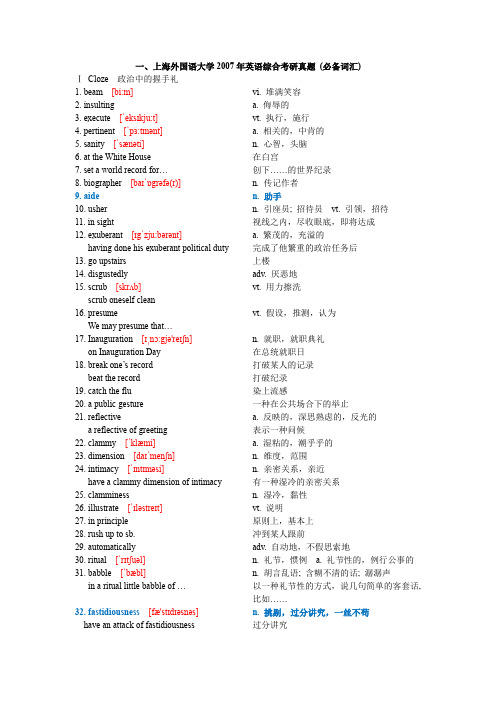
一、上海外国语大学2007年英语综合考研真题(必备词汇)ⅠCloze 政治中的握手礼1. beam [bi:m]vi. 堆满笑容2. insulting a. 侮辱的3. execute [ˈeksɪkju:t]vt.执行,施行4. pertinent [ˈpɜ:tɪnənt] a. 相关的,中肯的5. sanity [ˈsænəti]n. 心智,头脑6. at the White House 在白宫7. set a world record for…创下……的世界纪录8. biographer [baɪˈɒgrəfə(r)]n. 传记作者9. aide n. 助手10. usher n. 引座员; 招待员vt.引领,招待11. in sight 视线之内,尽收眼底,即将达成12. exuberant [ɪgˈzju:bərənt] a. 繁茂的,充溢的having done his exuberant political duty 完成了他繁重的政治任务后13. go upstairs 上楼14. disgustedly adv. 厌恶地15. scrub [skrʌb]vt.用力擦洗scrub oneself clean16. presume vt.假设,推测,认为We may presume that…17. Inauguration [ɪˌnɔ:gjə'reɪʃn]n. 就职,就职典礼on Inauguration Day 在总统就职日18. break one’s record打破某人的记录beat the record 打破纪录19. catch the flu 染上流感20. a public gesture 一种在公共场合下的举止21. reflective a. 反映的,深思熟虑的,反光的a reflective of greeting 表示一种问候22. clammy [ˈklæmi] a. 湿粘的,潮乎乎的23. dimension [daɪˈmenʃn]n. 维度,范围24. intimacy [ˈɪntɪməsi]n. 亲密关系,亲近have a clammy dimension of intimacy 有一种湿冷的亲密关系25. clamminess n. 湿冷,黏性26. illustrate [ˈɪləstreɪt]vt.说明27. in principle 原则上,基本上28. rush up to sb. 冲到某人跟前29. automatically adv. 自动地,不假思索地30. ritual [ˈrɪtʃuəl]n. 礼节,惯例 a. 礼节性的,例行公事的31. babble [ˈbæbl]n. 胡言乱语; 含糊不清的话; 潺潺声in a ritual little babble of …以一种礼节性的方式,说几句简单的客套话,比如……32. fastidiousness [fæ'stɪdɪəsnəs]n. 挑剔,过分讲究,一丝不苟have an attack of fastidiousness 过分讲究33. one’s extended hand某人伸出的手34. an awkwardness 一种尴尬35. outright a. 完全的,彻底的an outright insult 一种赤裸裸的侮辱36. fussy [ˈfʌsi] a. 挑剔的,过分讲究的,易怒的37. hygienic [haɪˈdʒi:nɪk] a. 卫生的,清洁的38. keep one’s sanity保持头脑清醒39. orgy [ˈɔ:dʒi]n. 狂欢40. grip-and-grin n. 欢快场合in an election year’s orgies of grip-and-grin 在大选之年的狂欢中41. mingle with…与……混在一起42. presumably [prɪˈzju:məbli]adv. 可能,据推测43. tens of thousands of… 成千上万个……44. germy [dʒɜ:mI] a. 带有细菌的45. graceful a. 优雅的,得体的46. substitute n. 替代,替补47. the Hindu Namaste ['nʌməsteɪ]印度合十礼48. clasp [klɑ:sp]vt.紧握49. alternative n. (另一种)选择 a. 替代的,备选的50. brandish [ˈbrændɪʃ]vt.挥舞51. clutch [klʌtʃ]vt.抓紧,紧握n. 紧抓,离合器two-handed a.两手操作的,左右手同样灵敏的brandish the two-handed clutch 挥舞双手52. champ [tʃæmp]n. 冠军53. look sb. in the eye 直视某人54. narcissism [ˈnɑrsɪsɪzəm]n. 自恋,自我陶醉55. physicality [ˌfɪzɪˈkæləti] n. 激情,热情,活力56. vestigial [veˈstɪdʒiəl] a. 残存的,退化的57. fleeting [ˈfli:tɪŋ] a. 短暂的; 稍纵即逝58. primitive [ˈprɪmətɪv] a. 原始的,落后的59. pulse n. 脉搏60. politician n. 政客,政治家61. work a rope line (政治家) 越出警戒线、仪规,进行亲民表演62. greedily adv. 贪婪地63. avidly adv. 渴望地,急切地;着迷,酷爱64. reach deep into the crowd 深入到群众中去65. cartoonist [kɑ:ˈtu:nɪst]n. 漫画家66. ceiling n. 天花板67. press (sb. to do sth.)vt.按,压;逼迫68. gluttonous ['ɡlʌtənəs] a. 贪吃的,贪婪的,馋的69. wade [weɪd](从河水、泥沼等)蹚过,走过; 跋涉wade into…抨击(某人),投入到……中wade into the human surf 涌入人潮之中wade into the discussion with sb. 投入到与……的讨论中70. claw [klɔ:]n. (动物的)爪; 钳v. 用爪抓(或挖)claw back…重新获得……,收回……get one’s claws into…占有,霸占……71. paw [pɔ:]n. 爪子,手v. 用爪子抓paw at…(用手、爪子)摸……72. the democratic mass n. 民众73. appetite n. 欲望; 胃口74. on the receiving side 在接受的一方75. souvenir [ˌsu:vəˈnɪə(r)]n. 纪念品76. frame n. 框架vt.陷害,设计 a. 有框架的keep a framed photograph of sb. 保存了某人的一副镶框照片77. beam at…对着……微笑78. post a little sign 做了一个小标记79. historical continuities 历史延续80. recall [rɪˈkɔ:l]vt.记起,想起,召回81. Senate [ˈsenət]n. (美国)参议院82. page (美国国会或州立法会的)青年助理a Senate page 一名参议院(青年)助理83. chamber [ˈtʃeɪmbə(r)]n. 会客室,议事厅,议院the Senate chamber 参议院议事厅the upper chamber 上院84. celebrity n. 名人85. 与其说……倒不如说……① not so much...as...Oceans do not so much divide the world asunite it.②rather than…Oceans unite the world rather than divide it.与其说海洋分隔了世界,倒不如说海洋联结了世界各国。
语言学及应用语言学试题答案整理

二、概念辨析:1.本体语言学与应用语言学的异同:本体语言学主要研究语言本身,包括对语言事实的静态的和动态的描写,对语言规律的揭示和说明,以及在此基础上所总结的各种语言理论。
应用语言学是研究语言本体和本体语言学同有关方面发生关系的学科。
应用语言学不仅有利于语言应用本身,而且也有利于加深对语言本身的认识。
同时,应用语言学研究的是语言本体和本体语言学同应用方面交叉的部分。
理论语言学:一般把研究某种具体语言的语言学称为汉语语言学或英语语言学等等,把侧重理论探讨的称为理论语言学。
2.语言的兼并和转用:语言借用是指在文化接触和语言接触的过程中从其他语言中借入自己语言所需要的成分,包括语音、词汇和语法的借用。
语音的借用表现为增加新的音位和增加新的音位组合方式。
语言转用是一个民族或民族的部分人放弃使用本民族语言而转用另一民族语言的现象。
语言兼用:双语或多语是指某一语言社团(民族或国家)或个人同时使用两种或两种以上的语言。
包括社会双语和个人双语。
双语就是语言接触中的语言兼用现象,包括双语和多语。
对一个民族发展来讲,语言兼用是进步的表现。
3 ,洋泾浜和混合语:两者都属于语言接触的特殊形式,同时,在语言传播过程中势必与当地语言发生密切关系,放弃自身的特点,吸收其他语言的特点。
洋泾浜也叫皮钦语,是临时混合语,常常只是用于在不同的族群之间的临时交际,如经商所需要的彼此之间的沟通,只使用于有限的范围,使用时间通常也不长。
语汇比较贫乏,语音和语法都不太规范,如旧上海的洋泾浜语把“我不能”说成My no can,用英语的词和汉语的语法;将number one说得像“拿摩温”。
由于“先天不足”,它通常的存活时间都不长,有的可能只存在几年。
克里奥尔语(Creoles)是正式混合语,一般是从洋泾浜发展而来的。
如果洋泾浜因为种种原因得到了发展,语言混合的程度较深,时间较长,语汇不断增加,语法规则不断完善,被有的族群作为母语来学习和使用,或者获得官方语言的地位,就成为克里奥尔语。
语言学及应用语言学真题锦集
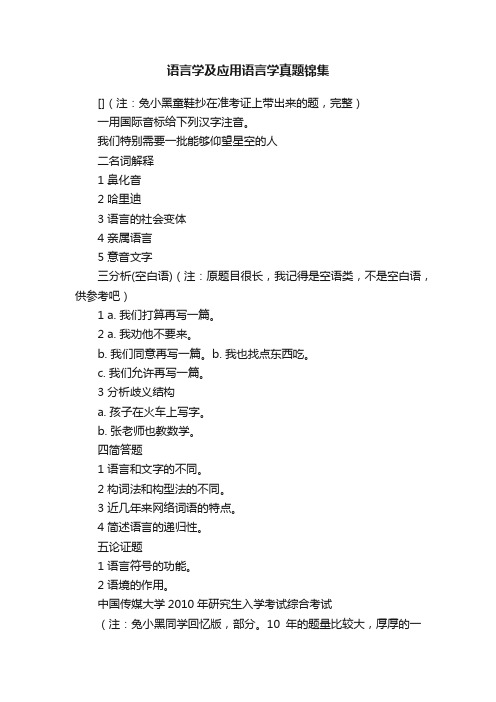
语言学及应用语言学真题锦集[](注:兔小黑童鞋抄在准考证上带出来的题,完整)一用国际音标给下列汉字注音。
我们特别需要一批能够仰望星空的人二名词解释1 鼻化音2 哈里迪3 语言的社会变体4 亲属语言5 意音文字三分析(空白语)(注:原题目很长,我记得是空语类,不是空白语,供参考吧)1 a. 我们打算再写一篇。
2 a. 我劝他不要来。
b. 我们同意再写一篇。
b. 我也找点东西吃。
c. 我们允许再写一篇。
3 分析歧义结构a. 孩子在火车上写字。
b. 张老师也教数学。
四简答题1 语言和文字的不同。
2 构词法和构型法的不同。
3 近几年来网络词语的特点。
4 简述语言的递归性。
五论证题1 语言符号的功能。
2 语境的作用。
中国传媒大学2010年研究生入学考试综合考试(注:兔小黑同学回忆版,部分。
10年的题量比较大,厚厚的一本试卷,不过答题时间应该是来得及的。
)现汉部分名词解释撮口呼句群通感区别词次方言构词方式脱贫特区离休飞播牵头简答题1调值和调类的关系2汉字标准化的内容3外来词类型4主语相对谓语动词有哪些语义关系类型古汉部分名词解释1隶变2古今字3章句4入声韵解释加点字,说明形旁和意义的关系古文加标点、翻译[/][]专业:语言学及应用语言学考试科目:语言学理论(总分150分,考试时间:3小时)一、术语解释(每条5分,共20分)1.克里奥尔语2.能指3.语言的地域变体4.历史比较语言学5.借源文字二、分析题(每题10分,共50分)1. 分析“饭卡、彩霞、航线、麻花”四个词语中八个音节的主要元音(韵腹)的音位及变体,并说明该变体产生的原因。
2.运用层次分析法画框式图的方式分析下列语言结构(要求分析到词)。
(1)英国科学家声称开发出可翻译外星人语言的计算机程序(2)建立汉语教师培训中心有助于中国文化在本地的发展3.识别下列语句中的歧义现象,并简述导致歧义的原因。
(1)小王说故事很有趣。
(2)连校长都不知道4.就“毕婚族、股民、晒工资、绿客、车奴、驴友、电话门”等分析现代汉语新词语现象。
语言学及应用语言学经典习题

语言学及应用语言学经典习题二、语言学及应用语言学经典习题(一)单项选择题1、关于语言符号的任意性,下列说法不正确的一项是( )A、复合符号原则上不是任意的,是有理据的B、正是由于语言符号的任意性,语言是可变的C、最基本的单纯初始符号都是任意的D、任意性是指一个符号先由某一个群体约定,继而向周围扩散推广2、关于书面语,下列表述不正确的一项是( )A、书面语是在口语的基础上产生的,经过加工和提炼,比较规范,所以,语言研究应该首先研究书面语B、书面具有相对的独立性C、任何语言总是先有口语,后有书面语D、书面语和口语的差异主要是风格上差异3、产生与18世纪末叶19世纪初叶的语言学被称为( )A、结构主义语言学B、历史比较语言学C、社会语言学D、功能语言学4、组合关系现在一般称为( )A、联想关系B、类聚关系C、句法功能D、语义组合5、语音的四个物理要素中,区别不同的意义起着最为重要的作用的是( )A、音高B、音强C、音长D、音色(二)、多项选择题在每小题列出的五个备选项中有二个至五个是符合题目要求的,请将其代码填写在题后的括号内。
错选、多选、少选或未选均无分。
1、一个元音的发音特征取决于( )A、起主要作用的部位B、声带是否振动C、唇形的圆展D、舌位的前后E、舌位的高低2、基本词汇的特点是( )A、数量最多B、使用范围广C、理据性强D、产生历史长E、构词能力强3、根据字符跟语言单位的语义还是语音相联系的标准可以将文字分为( )A、音节文字B、音位文字C、表意文字D、意音文字E、表音文字三、名词解释1、发音方法2、语法单位的构成关系四、简答题简述索绪尔对语言学的主要贡献。
五、分析题试从词语的构造方式的角度对下列合成词进行分类,分别填入相应的各项中:修辞阿姨瓜子燕子女儿马儿作者司仪刚刚第三作为忘记窗户木头开头后现代后年词根和词根组合的合成词词根和词缀组合的合成词前加式派生词后加式派生词六、论述题(本大题共2小题,第1小题10分,第2小题9分,共19分)举例说明几种主要的语法手段。
2007-2013外语用复试笔试真题汇总(回忆版)

2007年外国语言学与应用语言学复试情况回忆古代汉语整个围绕一段古文出的题, 就是古代汉语第一册的第一课, 说那个大王是他妈难产生下来的那一课. 首先是写出一些现代汉字的繁体字, 我记得有"认", "实"等共六个, 我写出四个吧. 然后就是课文词义解释, 就等于让你背古文注解, 这有十个题, 每个一分. 最后就是关于课文的一些提问, 总共四五个问题, 考得比较综合, 关于古文的一些特殊句式和用法, 我觉得是考到了宾语前置和使动用法. 但是听去年的学姐说就是考了一个古文的整段翻译, 好象是关于望洋兴叹的那一段. 照这么看来, 今年的古文题型就有很大的变化, 大家还是要从基础抓起, 从平时做起, 才能以不变应万变.英语国家概况今年考得巨简单, 从题型就可以看出来: 就是二十个选择题, 一个一分. 我记得第一个题就是问都柏林是哪个国家的英美文学对于我考这个方向的来说很简单, 都是主流作家的名字和作品的填空, 难度跟那些专八复习资料编的差不多, 只不过是填空就是了. 但是我后来注意到我有几处拼写错误了, 也要扣个三四分左右, 看大概来填空果然还是很需要小心的.语言学考得我感觉难度在文学之上. 先是十个填空, 我就晕了. 大概都是那种描述一个概念,然后让你指出他描述的概念是什么. 第二个题目是问答题, 有两个小题, 每个5分. 第一个是要你举例说明格莱斯的合作原则, 第二个是让你对一个观点作出评价, 那个观点好象是说: Language is about fuzziness大概是这样的.2008年复试考题现代汉语部分 20分一、填空题 16个, 1个1分1 普通话的基础方言是-------2 陈述句,疑问句,祈使句,感叹句是根据句子的-------划分的3 反切法是----------------------------两个音合成的就是定义题5个定义题6,7,8题是三个汉字注国际音标下来是五个词判断词的类型 5分三个短语的类型 3分二、短语成分分析 2个, 4分短语不长,挑一些简单的短语在下面练习练习就行古代汉语部分 20分词义解释比较多可能占十多分左右,这部分需要重点复习。
- 1、下载文档前请自行甄别文档内容的完整性,平台不提供额外的编辑、内容补充、找答案等附加服务。
- 2、"仅部分预览"的文档,不可在线预览部分如存在完整性等问题,可反馈申请退款(可完整预览的文档不适用该条件!)。
- 3、如文档侵犯您的权益,请联系客服反馈,我们会尽快为您处理(人工客服工作时间:9:00-18:30)。
416语言学概论"试题(完整版)一.术语解释(20分)1.语言2.组合关系3.音位4.合成词干5.语义场6.根词语7.随位音变8.区别性特征9.异根10.义素二.选择(20分)1.按语法手段进行分类,汉语和英语__. a.都属于分析语b.都属于综合语c.汉语属于分析语,英语属于综合语d.汉语属于综合语,英语属于分析语2.__不是超音段音位. a.重音b.停顿c.音渡d.同化3.汉语拼音中字母b所表示的音是一个__. a.送气音b.擦音c.清辅音d.浊辅音4."玻璃球"一词有__语素. a.一个b.两个c.三个5.语言中能独立运用的音义结合的最小语言单位是__. a.音素b.语素c.词d.句子6."老板"一词中"老"是__. a.词b.词根c.构词词缀d.构形词缀7.按照传统文字学,汉字属于__. a.语段文字b.表意文字c.表音文字d.音节文字8.美国描写语言学的代表人物是__. a.乔姆斯基b.索绪尔c.布龙菲尔德d.韩礼德9."啤酒"/pijiu/一词的发音中,/p/已经__. a.同化b.腭化c.鼻化d.变调10."葡萄酒杯"一词有__语素. a.一个b.两个c.三个d.四个11.在一个词中,__. a.只有一个词根b.至少有一个词根c.不一定有词根d.一定没有词根12.英语词desks和tables中复数语素"-s"的发音不同但书写上都用s表示,它遵循的拼写法原则是__. a.语音原则b.形态音位原则c.历史传统原则d.辨义原则13.下列词语中不是词汇单位的是__. a.风调雨顺b.吃一堑,长一智c.对不起d.黑墨水14.语音的本质属性是__. a.物理属性b.生理属性c.社会属性d.区别性特征15.__是历史比较语言学的奠基人之一. a.弗斯b.拉斯克c.叶尔姆斯列夫d.索绪尔16.在句子"书买来了"中,"书"在语义上是__. a.定指的b.不定指的c.通指的d.泛指的17."江""河"两词在古汉语中分别指"长江""黄河",在现代汉语中它们都由专名变为通名了,这种变化叫做__.a.语义扩大b.语义缩小c.语义转移d.派生新义18."to write a letter"短语中,"letter"在语义角色上是__. a.施事b.受事c.结果d.终点19."臭豆腐"和"酸牛奶"__. a."臭豆腐"是词,"酸牛奶"是词组b.都是词c."酸牛奶"是词,"臭豆腐"是词组d.都是词组20.就语言的共同来源而言,__的关系最近. a.汉语和日语b.汉语和韩语c.英语和德语d.英语和法语三.填空(20分)1.中国传统文学称为__,分为__、__、__三个分支.2.现代语言学的创始人是__,代表作是__.3.按照符号表示语言要素的功用,文字可分为__、__、__、__、__文字,古代汉字基本属于__文字.4.按谱系分类,俄语属于__语系__语族__语支.按类型分类法,汉语属于__.按语法手段分类,英语属于__,德语属于__.5.元音分类的三个主要标准是__、__、__.6.公元一世纪许慎的著作__分析了汉字结构,最早将汉字结构归结为"六书":象形、__、__、__、__和转注.7.符号学术语semantics、pragmatics、syntactic分别相当于语言学中的__、__、__.其中,__专门研究语言单位同交际主体之间的关系.8.联合国的正式语言和工作语言是汉语、英语、法语、俄语、__、__.9.表示附加词汇意义的词缀是构词词缀,表示语法意义的叫__词缀,如"桌子"一词中"子"是__词缀,workers中-er是__词缀,-s是__词缀,working中-ing是__词缀.10.转换生成语法的创始人是美国语言学家__,他认识语言学的研究对象是__而不是__.四.判断(30分)1.哥本哈根学派最突出的研究成果在音位学领域.2.英语词pie和spy中,[p]的发音有差异,它们都是音位/p/的条件变体.3.单义性、体系性和理据性是科技术语的特点.4.汉语是世界上唯一的声调语言.5.语义结合关系是语义在语言体系和语流中相互搭配而构成的一种关系.6.英语词walking有两个语素walk-和-ing,它们都是自由语素.7.aback一词只有一个语素.8.社会分化是语言分化的主要原因.9.不同语言义素组合虽然不同,但它们有一定的结构规律.10.语言中的一切结构要素都有规律的相互联系、相互制约,构成一个整体.11.汉语词"画家""国家"中的"家"都是词缀.12.传统语言学的内部分科有语音学、语义学、语法学和词汇学.13.语流分解中,音句和音词分别与语法上的句子和词相对应.14.汉语语音体系中,声调是音节的必要组成成分.15.元音和辅音发音时都有明显的部位感,但元音气流较弱,辅音气流较强.16.文字同思维没有直接联系,而是通过语言与思维发生联系.17.人们常说"什么阶级说什么话",这表明语言是有阶级性的.18.重音和声调都是由音强的变化决定的.19.布拉格学派的代表人物是布龙达尔和叶尔姆斯列夫.20.英语语音体系中,音位/t/和/b/的差异在于发音部位和清浊对立.21.送气音/p/和不送气音/p/在汉语语音体系中是两个不同的音位.22.根据语言功能特征的分类,普通话属于标准语,解放前上海使用的洋泾浜语是皮钦语.23.程式化是事务语体的重要特点.24.词符文字的书写符号表示词素,是最早的有序文字体系.25.汉语是主语主题并重型语言.26.汉语是综合性语言,主要通过词序和辅助词表示语法意义.27.语言体系内部各结构发展是不平衡的,其中词汇和语法发展速度最快.28.语言中固定的词的组合称为熟语,它们是现成的,不能任意改变.29.汉语词"外头"/waidou/在快速语流中常读作/waite/,这种音变属于联合音变.30.英语名词复数后缀-s在pens中发成/z/,在books中发成/s/,这种音变属于顺行同化.五.分析(20分)1.用直接成分分析法分析歧义结构(4分).(a)三个公司的经理(b)批评他的学生2.写出下列音素(6分)例:双唇鼻音--[m]a.舌后浊塞音b.齿龈清塞擦音c.齿间清擦音d.双唇清送气塞音e.半低前非圆唇元音f.半高后圆唇元音3.分析下列词的结构和构词法(10分)例: 心虚主谓式合干词词根词根a.葡萄b.老板c.老伴d.语言e.年轻六.问答(40分)1.世界上一些通用语言中,主要的语法范畴有哪些?(4分)为什么说其中很多范畴在汉语中是没有的?(3分)2.汉语拼音方案中的字母是标记音素的还是标记音位的?为什么?(5分)3.a.语言中表达语法意义的语法手段有哪些?用例子一一说明(6分)b.英语中I和me,am和is,bad和worse,look和looks,read和reading,come 和came,make和makes,lend和lent采用的各是什么语法手段?(4分)4.试论结构语言学的理论基础,并说出结构语言学的几个主要学派及其代表人物.(8分)5.有人说,英语词books中,其复数语法意义由-s语素形式表达,而单数名词book中,其单数语法意义没有语法形式表达.这句话正确吗?为什么?(6分)6.某文科大学开设了如下课程:现代汉语、古代汉语、汉语史、英语词汇学、法语语法学、东欧语言词汇史、现代汉语句法结构研究、古代汉语音韵研究.请你运用共时和历时的观点分析一下哪些课程属于共时语言学,哪些课程属于历时语言学.(4分)616现代汉语"试题(完整版)一.术语解释(举例说明,20分)1.句法扩展2.替换分析3.句法范畴4.塞擦音5.语义特征分析二.判断(20分)1."深入"的语素之间构成附加式关系.2."他真是羡慕死我了"当中补语有两种指向.3.开口呼的韵母都是i u v.4."筛选"属于主谓型合成词.5.[t]是舌尖中不送气清塞擦音.6."马虎"和"马马虎虎"的句法功能不同.7."'自由'被说成了'似由'"当中的宾语是受事宾语.8."认为"是谓宾动词.9."小丽跑得特别快"当中的补语属于程度补语.10."他唱歌唱得很好"当中的补语属于状态补语.11."小王本地人"和"小王是本地人"属于同一句型.12."客人住里屋"和"里屋住客人"当中"客人"的语用功能不同.13."婚姻大事我自己做主"是当事主语.14."大车"和"大的车"的语言单位不同,语法关系也有对立.15."一只蝴蝶"包含三个语素.16."他走回学校来"和"他拿回一本书来"之间的变换情况基本相同,属于同构模式.17."桌子上摆着一本书"和"书摆在桌子上"是同一句型的不同语用变换形式.18."男人就是男人"当中两个"男人"的义素存在不同之处.19."可控制"是一个词.20.[ts]属于舌尖前不送气清擦音.三.选择(20分)1."他简直笑死我了"这个语言片断有A.一种句法结构、一种语义结构B.两种句法结构、两种语义结构C.一种句法结构、两种语义结构 D.一种句法结构、三种语义结构2."这栋房子显然买贵了"的补语是A.状态补语B.结果补语C.程度补语D.可能补语3.A.疙瘩B.拖拉机C.苦头D.超声波当中的单纯词是( )4.舌面音能跟( )韵母拼合A.合口呼、开口呼B.开口呼、撮口呼C.撮口呼、齐齿呼5."怎么样,你?" A.有主语、无谓语B.无主语、有谓语C.有主语、有谓语D.无主语、无谓语6."美国人看中国并非铁板一块"这个语言片断有A.一种句法结构、一种语义结构B.两种句法结构、两种语义结构C.一种句法结构、两种语义结构D.两种句法结构、一种语义结构7."火车开走了"和"开走了一辆火车"当中"火车"的功能A.相同B.不同C.有时候相同,有时候不同D.以上都不对8.普通话中一个音节当中的辅音最多( ) A.三个B.一个C.两个D.四个9.主语A.有时候既是施事又是主题B.不可能既是施事又是主题C.有时候是主题但不可能是施事D.以上都不对10."树上结着苹果"当中"苹果"是A.关系宾语B.受事宾语C.施事宾语11.下列句子当中不属于主谓谓语句的是A.选择专业我自己做主B.小草叶子黄了C.他对这件事缺乏经验D.这个人,谁都喜欢他12."这件事情我一点也想不起来了"的补语属于A.结果补语B.状态补语C.可能补语D.程度补语13."车里坐着个人"合格,而*"车里坐着个王海"不合格,但"王海坐在车里"合格,这说明A.词语的性质对句法分布位置有某种条件要求,句法分布位置对词语的性质有某种条件限制B.词语的性质对句法分布位置有某种条件要求,句法分布位置对词语的性质没有条件限制C.词语的性质对句法分布位置不一定有条件要求,句法分布位置对词语的性质不一定有条件限制D.以上都不对14./x/的发音方法A.舌面后送气清塞音B.舌面前清擦音C.舌面前不送气清塞擦音D.舌尖后送气清塞擦音15."苹果我吃了"和"我吃了个苹果"当中A."苹果"的语用和词汇意义没有区别B."苹果"的语用意义有区别,词汇意义没有区别C."苹果"的词汇意义有区别,语用意义没有区别D.以上都不对16.下列词语中附加式合成词是A.降低B.船只C.马匹D.深入17.能愿动词一般放在"把"字句的A."把"字后B."把"字前C.均可D.视情况而定18."他扶老太太下车"和"他下车扶老太太"之间A.语义关系相同、句法结构不同B.语义关系不同、句法结构相同C.都相同D.都不同19."8号队员换了6号队员" A.一种句法结构、一种语义关系B.多种句法结构、一种语义关系C.一种句法结构、多种语义关系D.多种句法结构、多种语义关系20."她急死我了"和"她恨死我了"之间A.语义关系相同、句法结构不同B.语义关系不同、句法结构相同C.都相同D.都不同四.分析(50分)1.比较"他在上海住了10年"和"他在上海住了10年了"的不同.2.比较"他跳在地板上"和"他在地板上跳"有什么差异,并尝试得出结论.3.比较"造成""引起""致使"的异同.4.用层次分析法分析歧义结构A喜欢安静的客人B送走了学生的朋友5.用替换分析法,结合语义指向,详细分析"小李答应他明天去一趟北京"歧义的成因.五.论述(40分)1.比较AB两组结构的差异,并尝试对其合格的条件作出结论.A组(不合格) B组(合格)他把椅子坐了他把椅子坐破了他把椅子坐了他把椅子坐脏了2.比较"他3年前结过婚"和"他3年前结了婚"的差异.3.用合适的语言学方法分析"门口站着人"和"门口亮着灯"的差异,并设法解释其成因.4.简要概括汉语语法近20年来的理论和方法现状(不超过300字).(说出“我看过这本书”和“我看了这本书”的差异,并试着得出结论。
